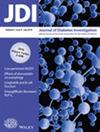A systematic analysis and prediction of the disease burden of ischemic heart disease caused by hyperglycemia
Abstract
Objective
This study aims to analyze the disease burden of ischemic heart disease (IHD) caused by hyperglycemia and its changing trend, and to construct a visualization platform for disease burden and forecast trends on the Shiny platform.
Materials and Methods
Using data from the 2021 Global Burden of Disease Study, we analyzed deaths and disability-adjusted life years (DALYs) due to IHD triggered by hyperglycemia, with detailed analysis by region, gender, and age. The age-period-cohort model was used to assess the impact of age, cohort, and period on age-standardized disease rates across different Socio-Demographic Index (SDI) regions, and decomposition analysis was employed to disentangle the contributions of population, aging, and epidemiological changes.
Results
In 2021, approximately 14–15% of IHD's DALYs and deaths were attributed to high fasting plasma glucose (HFPG), with a nonsignificant decrease in the annual average percentage change of DALYs. In middle, low-middle, and low SDI regions, the age-standardized mortality rates caused by HFPG are increasing, particularly among males. In high-middle and high SDI regions, the effects of aging and epidemiological changes surpass population growth, whereas in low SDI regions, population growth is the main factor. By 2050, the global Age-Standardized Mortality Rate of IHD attributed to HFPG is projected to reach 16.96. More data can be accessed by visiting the disease burden visualization platform.
Conclusion
Global HFPG-induced IHD health presents significant imbalances. In low SDI regions with larger populations and more unbalanced healthcare distribution, there is a need to strengthen the construction of medical levels.


 求助内容:
求助内容: 应助结果提醒方式:
应助结果提醒方式:


